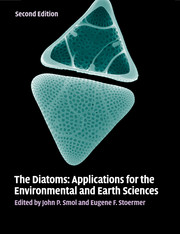Book contents
- Frontmatter
- Contents
- List of contributors
- Preface
- Part I Introduction
- Part II Diatoms as indicators of environmental change in flowing waters and lakes
- 4 Assessing environmental conditions in rivers and streams with diatoms
- 5 Diatoms as indicators of long-term environmental change in rivers, fluvial lakes, and impoundments
- 6 Diatoms as indicators of surface-water acidity
- 7 Diatoms as indicators of lake eutrophication
- 8 Diatoms as indicators of environmental change in shallow lakes
- 9 Diatoms as indicators of water-level change in freshwater lakes
- 10 Diatoms as indicators of hydrologic and climatic change in saline lakes
- 11 Diatoms in ancient lakes
- Part III Diatoms as indicators in Arctic, Antarctic, and alpine lacustrine environments
- Part IV Diatoms as indicators in marine and estuarine environments
- Part V Other applications
- Part VI Conclusions
- Glossary, acronyms, and abbreviations
- Index
- References
4 - Assessing environmental conditions in rivers and streams with diatoms
from Part II - Diatoms as indicators of environmental change in flowing waters and lakes
Published online by Cambridge University Press: 05 June 2012
- Frontmatter
- Contents
- List of contributors
- Preface
- Part I Introduction
- Part II Diatoms as indicators of environmental change in flowing waters and lakes
- 4 Assessing environmental conditions in rivers and streams with diatoms
- 5 Diatoms as indicators of long-term environmental change in rivers, fluvial lakes, and impoundments
- 6 Diatoms as indicators of surface-water acidity
- 7 Diatoms as indicators of lake eutrophication
- 8 Diatoms as indicators of environmental change in shallow lakes
- 9 Diatoms as indicators of water-level change in freshwater lakes
- 10 Diatoms as indicators of hydrologic and climatic change in saline lakes
- 11 Diatoms in ancient lakes
- Part III Diatoms as indicators in Arctic, Antarctic, and alpine lacustrine environments
- Part IV Diatoms as indicators in marine and estuarine environments
- Part V Other applications
- Part VI Conclusions
- Glossary, acronyms, and abbreviations
- Index
- References
Summary
Introduction
Assessments of environmental conditions in rivers and streams using diatoms have a long history in which two basic conceptual approaches emerged. First, based on the work of Kolkwitz and Marsson (1908), autecological indices were developed to infer levels of pollution based on the species composition of assemblages and the ecological preferences and tolerances of taxa (e.g. Butcher, 1947; Fjerdingstad, 1950; Zelinka and Marvan, 1961; Lowe 1974; Lange-Bertalot, 1979). Second, Patrick's early monitoring studies (Patrick, 1949; Patrick et al., 1954; Patrick and Strawbridge, 1963) relied primarily on diatom diversity as a general indicator of river health (i.e. ecological integrity), because species composition of assemblages varied seasonally and species diversity varied less. The conceptual differences in these two approaches really address two different goals for environmental assessments, one inferring pollution levels and the other determining biodiversity, a more valued ecological attribute (Stevenson, 2006). Thus, the concepts and tools for assessing ecosystem health and diagnosing causes of impairment in aquatic habitats, particularly rivers and streams, were established and developed between ∼50 and 100 years ago.
Today, diatoms are being used to assess ecological conditions in streams and rivers around the world (Asai, 1996; Kelly et al., 1998; Wu, 1999; Lobo et al., 2004; Wang et al., 2005; Chessman et al., 2007; Taylor et al., 2007; Porter et al., 2008). They have become valuable elements in large-scale national and international assessment programs of the United States and Europe (e.g. Kelly et al. 2009a).
- Type
- Chapter
- Information
- The DiatomsApplications for the Environmental and Earth Sciences, pp. 57 - 85Publisher: Cambridge University PressPrint publication year: 2010
References
- 78
- Cited by



